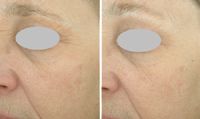- Acne
- Actinic Keratosis
- Aesthetics
- Alopecia
- Atopic Dermatitis
- Buy-and-Bill
- COVID-19
- Case-Based Roundtable
- Chronic Hand Eczema
- Chronic Spontaneous Urticaria
- Drug Watch
- Eczema
- General Dermatology
- Hidradenitis Suppurativa
- Melasma
- NP and PA
- Pediatric Dermatology
- Pigmentary Disorders
- Practice Management
- Precision Medicine and Biologics
- Prurigo Nodularis
- Psoriasis
- Psoriatic Arthritis
- Rare Disease
- Rosacea
- Skin Cancer
- Vitiligo
- Wound Care
Article
Improving photodamage: Clinical study corroborates efficacy, safety of conjugated linoleic acid treatment
The efficacy and safety of a cosmeceutical cream containing conjugated linoleic acid (CLA) for improving the appearance of facial photodamage skin was investigated in a 16-week, randomized, double-blind, split-face study of 25 women. Assessments of changes in periorbital skin showed statistically significant differences favoring use of the CLA-containing cream. No skin irritation was noted throughout the study.

Key Points
National report - Results of a randomized, double-blind, split-face clinical trial demonstrate that a cosmeceutical cream containing the natural ingredient conjugated linoleic acid (CLA) is nonirritating and significantly improves fine lines, wrinkles and overall appearance of photodamaged periorbital skin, compared with both baseline and vehicle control, researchers say.

"The absence of irritation associated with use of CLA-containing products in this and other studies is one of the unique features of CLA, compared to other active anti-aging ingredients, like retinol and alpha hydroxy acids, and the demonstration that CLA is both effective and nonirritating puts it in a class of its own.
CLA is a naturally occurring C18:2 lipid that belongs to a class of compounds known as cosmetic peroxisome proliferator-activated receptor (PPAR) lipids.
Commercially, CLA can be produced from food oils, such as safflower and sunflower oil, and over the past several years, PPAR biology has been studied for various benefits in dermatology applications.
"Unilever R&D has devoted over 12 years of research in the area of PPAR lipids, leading to the discovery of CLA; the clinical development program for CLA has included over 40 studies investigating its effects on photodamaged arm and facial skin.
"The results confirm its benefits, based on multiple histological and clinical changes, including increases in epidermal thickness and cell turnover, improved cell differentiation in the stratum corneum, and improved appearance of key aging appearance attributes, such as fine lines, wrinkles, and overall photodamage on facial and 'crepey' arm skin," Dr. Hawkins says.
Study parameters
The study, conducted by an independent contract research laboratory, enrolled 25 women ages 40 to 70 years old who had Fitzpatrick skin types I to III and moderate facial photodamage.
Outcomes were based on expert visual assessment of photodamage attributes in the periorbital region, including the appearance of crow's feet, under-eye lines and overall appearance, using a 10-point scale where 0 = none and 9 = severe. The assessments were made every four weeks, and differences between treatments were compared based on changes from baseline.
Improvements in all efficacy endpoints were already noted early in the study with the use of the CLA cream, and statistically significant differences favoring the CLA cream over vehicle were achieved at week 12. Continued use of the CLA cream was associated with further improvements, and the statistically significant differences between the CLA cream and vehicle were maintained at week 16.
"We have not conducted studies of CLA-containing products longer than 16 weeks, but anecdotal evidence indicates that the magnitude of improvement increases with continued use," Dr. Hawkins tells Dermatology Times.
Other studies
The research program has also included clinical studies in different countries in order to identify whether there are any ethnic-related differences in the benefits or safety of topical treatment with CLA.
"Results from studies enrolling Asian participants also showed that the CLA formulations caused little to no irritation. These findings were very encouraging because research published by ourselves and others indicates that Asian skin is typically more prone to irritation from topical treatments compared with Caucasian skin," Dr. Hawkins says.
CLA is a commercially available ingredient from Unilever for use in cosmetics formulations, although patents held by Unilever restrict what other manufacturers can formulate and claim in their skincare products. Commercially, CLA is currently found in Pond's Age Miracle in Asia and Europe and Dove ProAge in Europe.
Newsletter
Like what you’re reading? Subscribe to Dermatology Times for weekly updates on therapies, innovations, and real-world practice tips.











